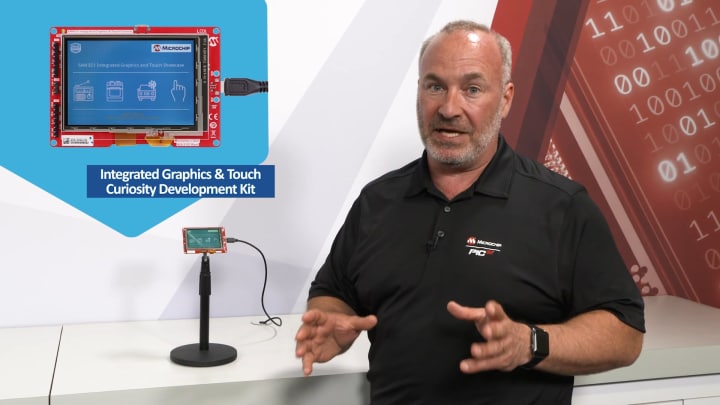The development tools for graphical displays are highly modular to allow many different sizes of glass to connect with various product families. The table below includes the recommended development board and display board needed for a fully functional development environment.
- MCUs/MPUs With Integrated Graphics Controller
- Low-Cost Controllerless Graphics
- External Graphics Controller
Similar Devices
Similar Devices
Similar Devices
Documents
- Application Notes
- Brochures
- Data Sheets
- Reference Manuals
- User Guides

Integrated Graphics and Touch (IGaT) Curiosity Development Kit
The Integrated Graphics and Touch (IGaT) Development Kit is a unique, low-cost user interface reference solution that uses a single Arm® Cortex®-M4-based SAM E51 MCU to implement both the graphics and the touchscreen.

Getting Started with the PIC32MZ DA Curiosity Development Kit
This video introduces the PIC32MZ DA Curiosity Development Kit and explains how to create a simple application on a PIC32MZ DA MIPS® core-based 32-bit microcontroller (MCU). It is supported by our free-to-use MPLAB® Harmony v3 embedded software development framework that runs in the MPLAB X Integrated Development Environment (IDE).

Attractive Embedded Graphics Using MPLAB® Harmony Graphics Suite (MHGS)
Attractive Embedded Graphics Using MPLAB® Harmony Graphics Suite (MHGS)
Embedding eye-catching graphics into designs across a wide range of controller cores, the MPLAB Harmony Graphics Suite provides professional tools, code and support to decrease your time to market and design risk while increasing brand preference and profitability for your products.

Microchip Graphics Solution for Human Interface Applications
Microchip Graphics Solution for Human Interface Applications
This is a graphics demo using our 16-bit PIC MCU and our free licensed library on a 3.2 TFT LCD panel. Our graphics building block is well suited for cost-effective human interface applications.

Graphics Display Designer Introduction
Graphics Display Designer Introduction
The Graphics Display Designer (GDD) is an MPLAB IDE plug-in that provides you with a quick and easy way of creating Graphical User Interface (GUI) screens for embedded applications on our microcontrollers (MCUs). The GDD is a visual design tool created for use with the Microchip Graphics Library. We created the library to work with a number of our graphics development boards.

Microchip Graphical Display Solutions
Microchip Graphical Display Solutions
Learn about our easy and cost-effective graphics solutions.